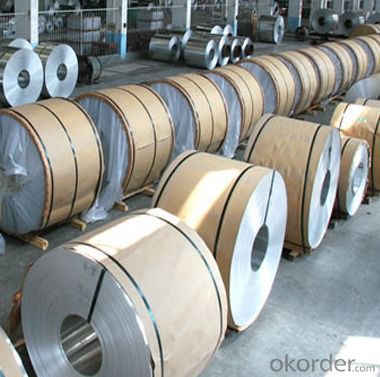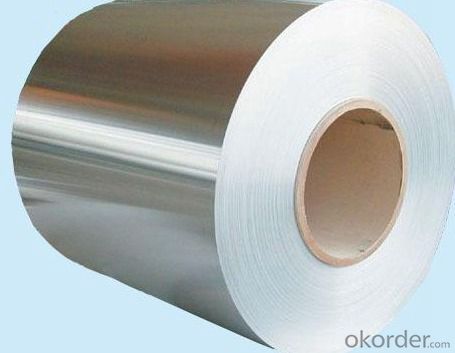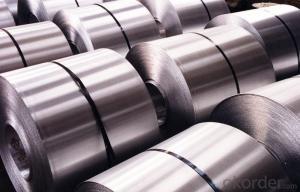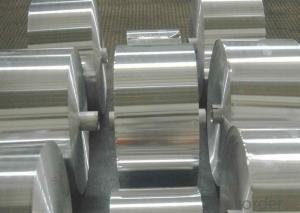Aluminium Coil for ACP (Aluminum Composite Panel)
- Loading Port:
- Shanghai
- Payment Terms:
- TT OR LC
- Min Order Qty:
- 1 m.t.
- Supply Capability:
- 2000 m.t./month
OKorder Service Pledge
OKorder Financial Service
You Might Also Like
Item specifice
Product Description:
The heat treatable alloys of 2000, 6000 and 7000 are such that when subjected to thermal temperatures, they again pronounced strengthening. Hence, tempers are indicated by "T". These alloys are also inventoried in clad form to increase corrosion resistance. All of the aluminum alloys are available in the annealed condition or commonly referred to as "O".
Aerospace - 2024, 6013, 6061, 7075
Construction - 3003, 5052, 6061
Electrical and Chemical Applications - 1100
General Machining Applications - 3003, 5052
Thickness from 0.18mm to more than 200mm are available for your needs. Aluminum can process to your special requirements and support traceability with complete Mill Test Certificate(MTC) and the essential industry specifications. More details about Aluminum sheet coil for Beverage Cans, Food Cans & Closures as following
Aluminum coil for aluminum composite panel
Always present in the development of aluminum coil for the Beverage Cans Making Industry, LingFeng offers Aluminum Coils for Beverage Can Body Stock, Coated End Stock and Bare or Coated Tab Stock. Lingfeng rolling facilities include: Modern equipment that guarantees high efficiency in the can makers lines and possible light-weight. A state-of-the-art lacquering line suitable for the coating of easy open end and tabe. PVC-free, BADGE-free and Solvent-free (free-based) lacquering systems are applied.
Being able to produce according to detailed customer requirements, Lingfeng can provide tailor-made solutions.
Aluminum sheet coil for Food Cans
New lacquerng line is suitable for the coating of bodies, lids and tabs of rectangular or round Food Cans for aggressive food or fruit-juice products. BADGE-free and Solvent-free (water-based) lacquering systems are applied. The material can also be supplied degreased, chromium phosphated and DOS treated.
Aluminum sheet coil for Closures
Committed to continuous development and full customer satisfaction, Lingfeng offers Pre-treated and Pre-coated Coils or Straight-cut Sheets for the production of Pilfer-proof Caps. Lingfeng provides high quality non-earing material, suitable for both one and two step Drawn Caps. Rolling experience and new lacquering facilities ensure excellent service in terms of products range and J. I. T deliveries providing Closures in three different aluminum alloys and two alternative finishes, bare or coated. Lingfeng material is used for the production of Pilfer Caps for carbonated and non-carbonated beverages, alcoholic or non-alcoholic drinks and as closures for pharmaceutical products.


Aluminium Coil PPGL Specification:
Quality Certification
According to EN and GB/T standards or as per agreed customer specifications.
Aluminum Coil for Beverage Cans, Food Cans and Closures Specifications
| Production Range (mm) | |||||
| Aluminum Sheets/Coils for Food Cans | Aluminum Sheets/Coils for Food Cans | ||||
| Thickness | Width | Thickness | Width | Length | |
| Body | 0.250 min. | 2300 max. | 0.18-0.25 | 500-1020 | 1045 max. |
| End | 0.222 min. | 2300 max. | 0.20-0.30 | 100-1020 | 1045 max. |
| Tab | 0.235 min. | 45 min. | 45 min | 29 min. | Coils only |
| Production Range (mm) | ||||
| Beverage Cans- Dimension | Food Cans-Coil Dimensions | |||
| Inside Diameter | Outside Diameter | Inside Diameter | Outside Diameter | |
| Body | 400 or 500 | 1850 max. | 400 or 500 | 1800 max. |
| End | 400 or 500 | 1850 max. | 300 or 400 or 500 | 1800 max. |
| Tab | 400 | 1850 max. | 300 or 500 | 1800 max. |
| Closures-Dimension Range | |
| Thickness | 0.20-0.3 |
| Width | 500-1020 |
| Length(Sheet) | 1045 max. |
| Inside Diameter | 300 or 400 or 500 on carton core |
| Outside Diameter | 1800 max |
| Finishes-Treatment | |||
| Beverage | Food | Closures | |
| Body: | Pre-lubricated: According to customer requirement. | Degreased, Chromium phosphate converted and DOS treated. | Pre-treated: Degreased, Chromium phosphate converted and if requested DOS treated. |
| End: | Pre-coated & Pre-maxed: According to customer requirements. | Pre-treated: Degreased, Chromium phosphate converted and DOS treated. Coated: Pre-waxed and lacquered on public or product side of the can, or both. | Coated: Lacquered on either or both sides. |
| Tab: | Coated: Clear or coloured expoxy, or bare: degreased and DOS re-oiled | Coated: Clear or coloured coated or bare: degreased and DOS re-oiled | |
FAQ of Aluminium Coil for ACP (Aluminum Composite Panel):
1.Superior quality of raw material.
2.Reasonable and stable chemical composition.
3.Accurate tolerance.
4.Goode mechanical property.
5.We have the certificate of ISO9001.
- Q:How are aluminum coils coated or finished?
- Various methods can be employed to coat or finish aluminum coils, enhancing their aesthetic appeal, protecting against corrosion, and improving functionality. The most common techniques include painting, anodizing, and laminating. Painting, a popular coating method, involves the application of a paint layer onto the aluminum surface. This can be accomplished using various techniques such as spray painting, roll coating, or coil coating. Customization options for the paint include color, gloss level, and texture, offering a wide range of aesthetic possibilities. Additionally, painting provides protection against atmospheric conditions and increases coil durability. Anodizing, another widely utilized technique, particularly in architectural and industrial applications, entails the creation of a controlled oxide layer on the aluminum surface through an electrochemical process. Anodized aluminum coils possess a uniform and durable finish, enhancing resistance to corrosion, scratching, and fading. They are available in various colors and can be further enhanced with a matte, brushed, or polished appearance. Laminating involves the application of a thin protective film onto the aluminum coil's surface. This film can be composed of materials such as PVC, polyester, or polyethylene. Laminating offers an additional layer of protection against scratches, dirt, and UV radiation. It also facilitates easy cleaning and maintenance of the coated aluminum coils. Besides these methods, specialized finishes can be applied to aluminum coils for specific applications. For instance, coils employed in the automotive industry may feature a polymer-based coating, enhancing lubricity and reducing friction. Coils used in the construction sector may incorporate a heat-reflective coating to improve energy efficiency. In conclusion, the coating or finishing of aluminum coils plays a vital role in enhancing their appearance, protecting against corrosion, and improving functionality for diverse applications. The choice of coating method depends on desired outcomes, budget, and specific requirements within the end-use industry.
- Q:How are aluminum coils used in the automotive industry?
- Aluminum coils play a crucial role in the automotive industry due to their numerous advantages over traditional materials. These coils are widely used in various parts and components of vehicles to enhance performance, improve fuel efficiency, and reduce overall weight. One of the primary applications of aluminum coils in the automotive industry is in the manufacturing of heat exchangers, such as radiators and condensers. Aluminum's excellent thermal conductivity allows for efficient heat transfer, helping to regulate the engine temperature and optimize its performance. By using aluminum coils in heat exchangers, vehicles can achieve better cooling efficiency, which is essential for preventing engine overheating and maintaining optimal operating conditions. Additionally, aluminum coils are used in the production of air conditioning systems, particularly in the condenser and evaporator units. These coils provide excellent heat exchange capabilities, allowing for efficient cooling or heating of the vehicle's interior. As a result, vehicles equipped with aluminum coil-based air conditioning systems can provide a comfortable environment for passengers while minimizing energy consumption. Moreover, aluminum coils are utilized in the construction of lightweight body panels and structural components, such as doors, hoods, roofs, and chassis. Aluminum's high strength-to-weight ratio makes it an ideal material for reducing the overall weight of vehicles without compromising structural integrity. This weight reduction leads to improved fuel efficiency, reduced emissions, and enhanced performance, including acceleration, handling, and braking. Furthermore, aluminum coils find application in the production of electrical systems in automobiles. Due to their excellent electrical conductivity, these coils are used in wiring harnesses, connectors, and other electrical components. The use of aluminum coils in these systems ensures efficient transmission of electrical signals and reduces the overall weight of the vehicle, contributing to improved fuel economy. In summary, aluminum coils are extensively utilized in the automotive industry for various applications, including heat exchangers, air conditioning systems, body panels, and electrical components. Their exceptional properties, including thermal conductivity, strength-to-weight ratio, and electrical conductivity, enable automakers to produce lighter, more efficient, and environmentally friendly vehicles.
- Q:What are the different coil recoiling options available for aluminum coils?
- There are several coil recoiling options available for aluminum coils, depending on the specific requirements and desired outcomes. One option is the oscillate recoiling method, which involves winding the aluminum coil in a zigzag pattern. This technique helps to reduce coil set and improve flatness, making it suitable for applications where a flat, smooth surface is crucial. Another option is the traverse winding method, which involves winding the aluminum coil back and forth in a controlled manner. This technique helps to evenly distribute the tension across the coil, reducing the risk of coil breaks and ensuring consistent performance. Additionally, there are options for coil slitting and rewinding. Slitting involves cutting the aluminum coil into narrower strips, which can be rewound into smaller coils. This option is commonly used when smaller coil sizes are required for specific applications. Furthermore, some recoiling options include coil rewinding with tension control systems. These systems ensure that the tension applied during rewinding is controlled and consistent, helping to prevent overstretching or deformation of the aluminum coil. Overall, the choice of coil recoiling options for aluminum coils depends on factors such as the desired surface finish, coil size requirements, and specific application needs. Manufacturers and processors of aluminum coils can provide guidance and expertise in selecting the most suitable recoiling option based on these considerations.
- Q:Are aluminum coils suitable for food processing and packaging?
- Yes, aluminum coils are suitable for food processing and packaging. Aluminum is a safe and hygienic material that is resistant to corrosion, odors, and moisture. It is commonly used for packaging food products due to its ability to maintain the freshness and quality of the food, preventing contamination and providing a longer shelf life. Additionally, aluminum coils are lightweight, flexible, and can be easily formed into various shapes and sizes, making them ideal for food packaging applications.
- Q:Can aluminum coils be used in the production of aluminum composite ceilings?
- Aluminum composite ceilings can indeed incorporate aluminum coils. The utilization of aluminum coils as the foundational material for manufacturing aluminum composite panels is quite common. These panels, in turn, serve as the foundation for constructing ceilings. The coils themselves typically consist of high-quality aluminum alloy and have undergone numerous processes to guarantee their durability, strength, and visual appeal. For added protection, the aluminum coils are coated with a layer of either PVDF or polyester. This coating serves to enhance their resistance to weathering, UV rays, and corrosion. Additionally, this protective layer allows for a wide array of color options, thus providing ample flexibility in design choices for aluminum composite ceilings. In summary, aluminum coils play a vital role in the production of aluminum composite ceilings. They offer a lightweight, fire-resistant, and long-lasting solution for a variety of architectural and interior design applications.
- Q:i dont want aluminum cookware, but how about a stainless steel set with an aluminum core. Is this the same as aluminum pots and pans? Thanks.
- The aluminum is encased in the stainless steel, usually as a thick disk in the bottom. It is an excellent conductor of heat and holds the heat well once it gets hot. All you see is the stainless, none of the aluminum because it's between two layers of stainless in the bottom of the pots. You are right, you don't want food cooked in straight aluminum, some metal taste can transfer to certain foods. That won't happen with stainless.
- Q:Why 5052 turn black after annealing during the production of aluminum alloy?
- The aluminum oxide in the surface has been oxidized by other chemical elements.
- Q:What are the different coil slitting methods used for aluminum coils?
- There are several coil slitting methods used for aluminum coils, each with its own advantages and applications. Here are some of the common methods: 1. Rotary Shear Slitting: This method involves using rotating circular knives to cut the aluminum coil into narrower strips. It offers high precision and speed, making it suitable for producing large volumes of narrow strips with consistent widths. 2. Loop Slitting: In this method, the aluminum coil is passed through a loop, where it is cut using rotating knives. Loop slitting allows for high-speed processing while minimizing the risk of damage to the coil's surface. It is commonly used for thinner gauge aluminum coils. 3. Double Knife Slitting: As the name suggests, this method involves using two blades to make parallel cuts along the length of the aluminum coil. Double knife slitting is suitable for thicker gauge coils and can produce wider strips compared to other methods. 4. Scissors Slitting: This method utilizes a pair of scissors-like blades to cut the aluminum coil into strips. Scissors slitting is versatile and can handle a wide range of coil thicknesses. It is often used for smaller scale operations or when precise width tolerances are not critical. 5. Crush Slitting: In crush slitting, the aluminum coil is pressed against a hardened roller or blade, causing it to deform and rupture along the desired cutting line. This method is ideal for delicate materials or when minimal burr formation is desired. Each slitting method has its own set of advantages and limitations, and the choice depends on factors such as coil thickness, desired strip width, production volume, and surface quality requirements. It is crucial to select the appropriate method to ensure efficient and accurate slitting of aluminum coils.
- Q:What are the different pre-treatment methods for aluminum coils?
- Some of the different pre-treatment methods for aluminum coils include cleaning, degreasing, etching, and phosphating. Cleaning removes dirt, dust, and other impurities from the surface of the coil. Degreasing eliminates oils and greases that may be present. Etching creates a rough surface on the aluminum, which helps in improving adhesion for subsequent coatings. Phosphating involves applying a phosphate coating to enhance corrosion resistance and improve paint adhesion. These pre-treatment methods ensure that the aluminum coils are properly prepared before any further processing or coating.
- Q:Can aluminum coils be used in agricultural applications?
- Yes, aluminum coils can be used in agricultural applications. Aluminum is a versatile and durable material that can withstand various environmental conditions, making it suitable for agricultural equipment such as irrigation systems, greenhouse structures, and ventilation systems. Additionally, aluminum's light weight and corrosion-resistant properties make it an ideal choice for agricultural applications where durability and long-term performance are essential.
1. Manufacturer Overview |
|
|---|---|
| Location | |
| Year Established | |
| Annual Output Value | |
| Main Markets | |
| Company Certifications | |
2. Manufacturer Certificates |
|
|---|---|
| a) Certification Name | |
| Range | |
| Reference | |
| Validity Period | |
3. Manufacturer Capability |
|
|---|---|
| a)Trade Capacity | |
| Nearest Port | |
| Export Percentage | |
| No.of Employees in Trade Department | |
| Language Spoken: | |
| b)Factory Information | |
| Factory Size: | |
| No. of Production Lines | |
| Contract Manufacturing | |
| Product Price Range | |
Send your message to us
Aluminium Coil for ACP (Aluminum Composite Panel)
- Loading Port:
- Shanghai
- Payment Terms:
- TT OR LC
- Min Order Qty:
- 1 m.t.
- Supply Capability:
- 2000 m.t./month
OKorder Service Pledge
OKorder Financial Service
Similar products
New products
Hot products
Related keywords






























